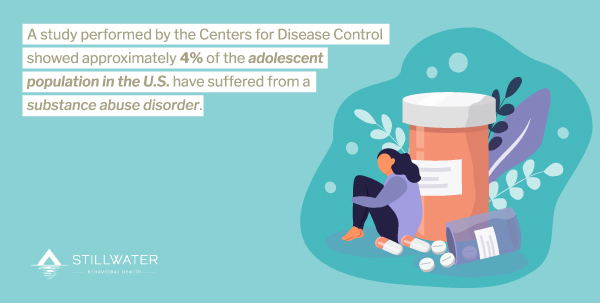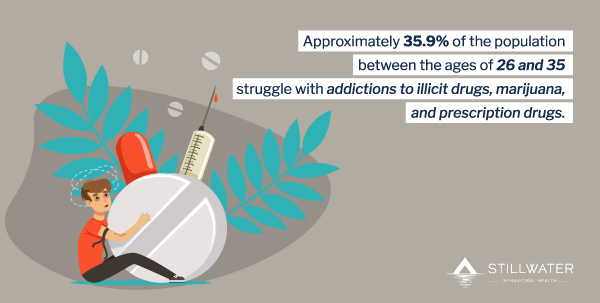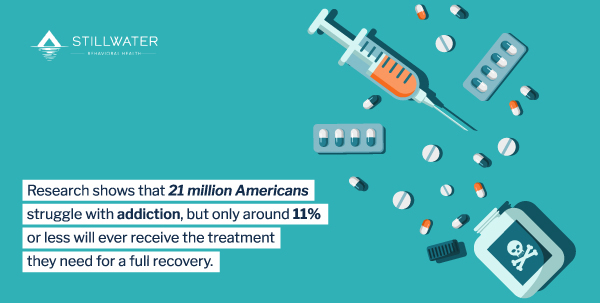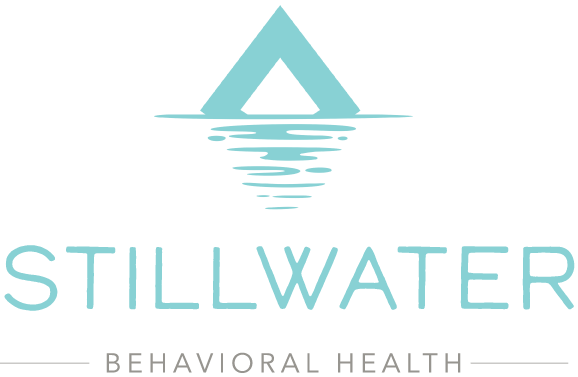Drug Abuse Statistics
Facts on Drug Use
Addiction touches the lives of millions of Americans each year. Regardless of age, race, religion, economic standing, or other traceable demographic, hundreds of thousands of individuals use drugs or alcohol for the first time every year. Additionally, millions more continue to struggle with ongoing addiction to opioids, alcohol, prescription medications, or illicit substances.
Unfortunately, struggles with addiction know no boundaries. Annually, millions of parents, coworkers, friends, and even children lose their lives to overdose. Although many statistics related to addiction are well known, reviewing annual data helps to highlight some of the more common struggles related to drug and alcohol addiction and addiction treatment.
Questions about addiction?
Call Us Now: 1-866-232-9103
Your call is confidential with no obligation required to speak with us.
The Swiss Cheese Model of Drug Addiction
The Swiss Cheese Model of Drug Addiction
Why Are Drugs Addictive?
How Drugs Affect the Brain
Data on First-Time Drug Use

Because alcohol and tobacco products are legally purchased substances, many young people don’t consider the highly addictive nature of tobacco abuse and alcohol abuse. However, these substances kill millions of people from disease and other situations directly linked to alcohol and tobacco addiction every year. According to the 2018 NSDUH, nearly five million Americans over the age of 12 began using alcohol in the past year.2
Illicit Substance Use
In addition to tracking alcohol and tobacco use, the NSDUH also tracks illicit substances. The first-time statistics for substances including marijuana, prescription tranquilizers, hallucinogens, stimulants, cocaine, inhalants, sedatives, methamphetamines, opioid pain medications, and heroin, are tracked by the annual survey.
Prescription medication addiction is a struggle faced by Americans of all ages. Like alcohol, prescription medications are provided by legal means. This means many adolescents and adults don’t consider the addictive nature of prescription drugs until it’s too late and prescription addiction has developed.
Types of Drug Abuse

Unintentional
Some people develop an addiction to drugs unintentionally. This can occur when someone takes a prescription drug as part of a treatment plan prescribed by their primary care provider. This could be a medication to help manage pain or help with a mental health condition. Unfortunately, although beneficial as part of a treatment program, many of these medications also carry a significant risk for addiction if used long-term or misused.
In time, when the prescription expires, or the individual no longer has access to their drug of choice, they may turn to illicit substances to help satisfy cravings to use. Prescription painkillers also frequently lead to addiction, as someone who uses prescription painkillers long-term can become addicted to the effects of the drug. Someone struggling with chronic pain who tries to wean off a long-term pain medication will experience withdrawal symptoms and side effects, making it difficult to stop using the drug.
Intentional Self-Harm
Causes of Addiction
- Genetics (biology)
- Environmental factors
- Underlying mental health conditions
- Substance use disorder that evolves out of prescription medication dependency
Genetics
Environmental Factors
Mental Health Disorders
Prescription Medication Dependence
Statistics on Addiction in America

How Do Drug Work on the Brain?
Mind Matters: How do Drugs Work on the Brain?
Drug Use Statistics in Specific Populations

Statistics on Addiction to Specific Substances
Opioid Statistics
The opioid epidemic continues to present treatment and healthcare challenges across the nation. Opioids of all kinds, prescription and illicit, have led to a significant rise in drug-related overdose over the last decade.
Alcohol, Marijuana, and Tobacco Statistics
Meth, Cocaine, and Hallucinogens Statistics
Drug abuse statistics suggest addictions to methamphetamine, cocaine, inhalants, hallucinogens, and prescription drugs remain challenges across all demographics. Addiction statistics by race indicate African Americans experience addiction to these and other substances at rates similar to Caucasians and other populations. Approximately 5 million Americans are addicted to cocaine, and nearly 15,000 died of cocaine-related causes in 2018.
Addiction Treatment Statistics
Addiction treatment programs that provide evidence-based detox and therapeutic care are proven successful in helping people overcome an alcohol or drug addiction. Unfortunately, drug abuse statistics and research suggest that too few of those who could benefit from addiction treatment will ever receive the help they need at an addiction treatment center. Overall estimates indicate as many as 21 million Americans struggle with at least one addiction. Of those, 11% or less will ever receive the help they need to put those struggles in the past.8

Professional Rehab Center
Dangers of At-Home Detox
Addiction Relapse Rates
Why Are Drugs So Hard to Quit?
Why are Drugs So Hard To Quit
Addiction Treatment
Detox with Medication-Assisted Therapy
Aftercare
Resources
- https://www.drugabuse.gov/publications/drugfacts/understanding-drug-use-addiction
- https://www.samhsa.gov/data/sites/default/files/cbhsq-reports/NSDUHNationalFindingsReport2018/NSDUHNationalFindingsReport2018.pdf
- https://www.justice.gov/usao-nv/heroin-and-opioid-awareness
- https://www.verywellmind.com/what-are-the-costs-of-drug-abuse-to-society-63037
- https://www.airforcemag.com/new-pentagon-report-pegs-air-force-one-cost-at-52-billion/
- https://www.cdc.gov/nchs/data/hus/2018/020.pdf
- https://www.drugabuse.gov/drug-topics/publications/research-reports
- https://www.naatp.org/addiction-treatment-statistics


